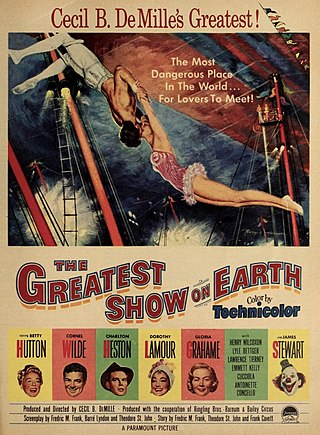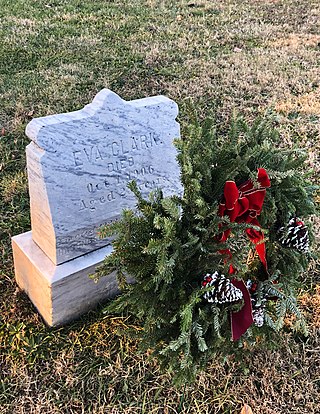
The Greatest Show on Earth is a 1952 American drama film produced and directed by Cecil B. DeMille, shot in Technicolor and released by Paramount Pictures. Set in the Ringling Bros. and Barnum & Bailey Circus, the film stars Betty Hutton and Cornel Wilde as trapeze artists competing for the center ring and Charlton Heston as the circus manager. James Stewart also stars as a mysterious clown who never removes his makeup, and Dorothy Lamour and Gloria Grahame also play supporting roles.

Emmett Leo Kelly was an American circus performer, who created the clown character "Weary Willie", based on the hobos of the Great Depression in the 1930s.

A circus is a company of performers who put on diverse entertainment shows that may include clowns, acrobats, trained animals, trapeze acts, musicians, dancers, hoopers, tightrope walkers, jugglers, magicians, ventriloquists, and unicyclists as well as other object manipulation and stunt-oriented artists. The term circus also describes the field of performance, training and community which has followed various formats through its 250-year modern history. Although not the inventor of the medium, Newcastle under Lyme born Philip Astley is credited as the father of the modern circus.
Saltimbanco was a touring show by Cirque du Soleil. Saltimbanco ran from 1992 to 2006 in its original form, performed under a large circus tent called the Grand Chapiteau; its last performance in that form was in Rio de Janeiro, Brazil, on December 10, 2006. A new adaptation of the show started touring North America on July 31, 2007, with its first stop in London, Ontario, Canada. The new version was staged in arenas with fewer performances in each city it visited. The new version closed at the end of 2012.

A circus train is a method of conveyance for circus troupes. One of the larger users of circus trains was the Ringling Bros. and Barnum & Bailey Circus (RBBX), a famous American circus formed when the Ringling Brothers Circus purchased the Barnum and Bailey Circus in 1907.

The title Moscow State Circus is used for a variety of circuses. Most commonly, it refers to one of the two circus buildings in Moscow, the "Circus Nikulin" and the "Bolshoi Circus", or to traveling shows which may or may not be directly related to Russia.

The Hagenbeck–Wallace Circus was a circus that traveled across America in the early part of the 20th century. At its peak, it was the second-largest circus in America next to Ringling Brothers and Barnum and Bailey Circus. It was based in Peru, Indiana.

Johann Ludwig Jacob, professionally known as Lou Jacobs, was a German-born American auguste clown who performed for Ringling Bros. and Barnum & Bailey Circus for more than 60 years. He was inducted into the International Clown Hall of Fame in 1989. He is credited with popularizing the clown car, which has been a staple of circus clown acts ever since. He is also often cited as the originator of the red rubber ball nose, which is used by many clowns today. He was the first living person to have his portrait appear on an American postage stamp.
Circus Contraption was the name of a one-ring circus, vaudeville and dark cabaret troupe based in Seattle, Washington. The troupe, which employs about a dozen performers, uses live, original music paired with old-style circus performances, heavily influenced by cabaret and vaudeville acts. The shows are conceived for adults and usually feature some mature content.
Elvin Bale is a former artist and daredevil with Ringling Bros. and Barnum & Bailey Circus, among many other international circuses. He performed a single trapeze act which finished with a heel catch. Among his other acts were the "wheel of death", "human space shuttle", "mechanical monster", "motorcycle on the high wire" and human cannonball. His career as a performer ended on January 8, 1987, when, performing the human cannonball, he over-shot his landing cushion, breaking his legs and back and paralyzing him from the waist down.

The Sells Floto Circus was a combination of the Floto Dog & Pony Show and the Sells Brothers Circus that toured with sideshow acts in the United States and Canada during the early 1900s.
Circus Flora is a one-ring circus based in St. Louis, Missouri, United States. It is a non-profit organization. Circus Flora has become a touring show yet it performs annually in St. Louis, usually at the beginning of the month of June. It combines the venue of a one-ring circus with the performance trappings of theatre. Performances include aerialists, equestrian artists, acrobats, and trained animals. Each performance is accompanied by a live band. Live musicians allow the mood to be tailored to the live events happening in the ring — down to every crash of the cymbal or beat of the snare drum.
Samuel Lockhart (1851–1933) was a famous Victorian elephant trainer and the second child of the famous Lockhart circus family. His work with elephants took him all over the UK, including Royal command performances in front of Queen Victoria, Europe and in the USA, where he worked for the famous Ringling Brothers Circus from 1896 to 1901. He has appeared in several historical books on the circus(SOURCE?), including one children's book completely dedicated to him, and the English town of Leamington Spa has several areas named after his most famous group of elephants "The Three Graces".
Barnum's Kaleidoscape was an American circus staged by Feld Entertainment, the owners of Ringling Bros. and Barnum & Bailey Circus, at a start-up cost of $10 million. It ran for one season, 1999–2000. Inspired by both European traditions and the contemporary circus movement, it was the first Ringling show to be held under a tent since 1956 and also its first one-ring presentation in more than a century. The tent was carpeted with wood flooring and amenities to create an intimate setting with seating for 1,800 on cushioned seats and sofas and no one further than 50 feet from the circus ring. Besides traditional circus fare like popcorn upscale items such as cappuccino and veggie wraps were offered. The show consisted of 62 performers, 54 crew members, 8 horses and 27 geese, with 50 trucks involved in moving it from site to site.

Wanderlust Circus is a theatrical circus troupe based in Portland, Oregon, founded in 2006 by creative partners Noah Mickens and Nick "The Creature" Harbar. Since 2006, Wanderlust Circus has grown from a small band of creatives to a full-fledged circus troupe, and non-profit organization. The organization presently comprises a team of acrobats, a 10-piece swing band, a trick-roping cowboy clown; and several aerialists, contortionists, hand balancers, jugglers, and dancers. Their most popular recurring shows have been The White Album Christmas, A Circus Carol, and the dance party series MegaBounce.

The Circus Queen Murder is a 1933 American pre-Code mystery film directed by Roy William Neill and starring Adolphe Menjou, Donald Cook and Greta Nissen. It is the sequel to the 1932 film The Night Club Lady in which Menjou had also starred as Thatcher Colt. The film is based on a story by "Anthony Abbott", a pseudonym used by Fulton Oursler.
Scot Nery's Boobie Trap is a long-running weekly live performance variety arts show in Hollywood, California. Performances are every Wednesday, featuring an average of 15 acts each week, with much adult content. Performers include musicians, ventriloquists, comedians, knife throwers, dancers, Magic Castle magicians, jugglers, acrobats and contortionists, circus acts, and other variety entertainers. Nery founded the show in 2015, and it is co-produced by Meranda Carter.
Kaely Michels-Gualtieri is an American trapeze artist known for her work as a leading artist with the Ringling Bros. and Barnum & Bailey Circus, often performing under the stage name "Electra". She is the winner of two Golden Flyer Awards as one of the world's leading swing trapeze artists. She won a Silver Ring, Russia's highest trapeze honor, in 2017. She is the youngest person ever nominated for membership in the Circus Hall of Fame.

Eva Clark was a headlining aerialist and circus performer. She was shot in the abdomen by her estranged husband, Lum "Roser" Clark, after a show with Cole Bros. World-Famed Triple Railroad United Shows on September 6, 1906 in Staunton, Virginia, and died on October 1, 1906, from surgical complications. In the years prior to her death, newspapers referred to Eva as the "Queen of the Air".

John Lester was an American traveling carnival showman and variety show impresario. He headed a family of entertainers who often performed together, and in later life worked mainly in Britain. His sons Harry and Burton Lester were also prominent variety show entertainers. The family performed a wide variety of acts, but were most notable for their midget shows, and for Harry Lester's comedy hillbilly music performances.















